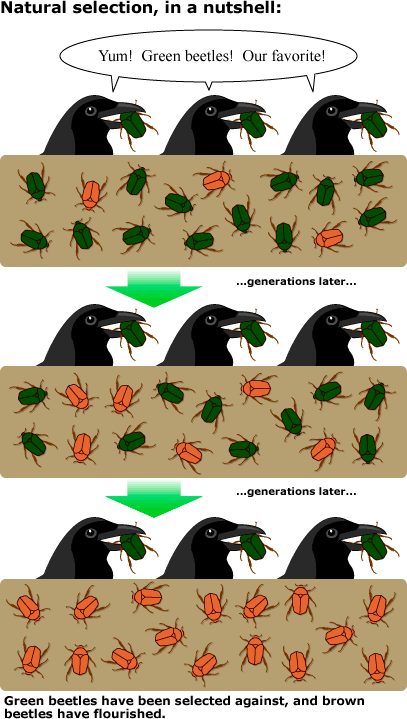Which word matches this definition?
"A change in a sequence of DNA"
Mutation
In the image below, what is the selective pressure and variation?

Selective Pressure: Birds (predators
Variation: green or orange beetles
Identify two components of natural selection in the scenario below (Variation, Inheritance, Differential survival and reproduction, and Adaptation):
Peppered moths vary in color. Some are lighter and some are darker in coloration. Before the industrial evolution, only 2% of the moths were darker. After the industrial evolution, 95% of the moths had the darker coloration. Birds eat the moths they can see on trees.
V: light or dark moths
I: Color being passed down from parents to offspring
D: Dark moths survive more than light moths (2% to 95%)
A: Being dark
Which word matches this definition?
"An evolutionary force that causes a particular phenotype to be more favorable in certain environmental conditions"
Selective pressure
In the image below, which beetles are more fit and what is the adaptation?

More fit beetles: The orange beetles
Adaptation: Being orange
Identify two components of natural selection in the scenario below (Variation, Inheritance, Differential survival and reproduction, and Adaptation):
Some works eat at night and some worms eat during the day. Most birds eat during the day. Each spring when the works reproduce, about 500 offspring are born but only 100 of them live long enough to reproduce.
V: eat during day or eat during night
I: eating timing inherited (or possibly not)
D: Only 100/500 survive and reproduce. Worms who eat during the day have lower survival
A: Eating during the night
Which word matches this definition?
"A characteristic which is influenced by genes and passed from parents to offspring"
Heritable
Why is variation important for natural selection?
It provides traits for natural selection to act upon
Identify the four components of natural selection in the scenario below (Variation, Inheritance, Differential survival and reproduction, and Adaptation):
Some emus run fast (30-35 mph) and others run slower (20-25 mph). Dingoes are the main predators of emus and can reach speeds up to 30 mph. Emus lay 30-50 eggs a year, but only 20 live long enough to reproduce
V: Emus running fast or slower
I: speed being passed down (or not) through offspring
D: 20/30-50 survive long enough to reproduce; fast emus survive more
A: Running fast enough to outrun predators
Which word matches this definition?
"An organism's ability to pass its genetic material to its offspring"
Fitness
What would be the selective pressure for why bears grow thick fur in the winter?
The cold climate
Identify the four components of natural selection in the scenario below (Variation, Inheritance, Differential survival and reproduction, and Adaptation) AND identify the selective pressure:
Polar bears tend to have varying thickness in coats: some are thin, some are medium, and some are thick. Due to climate change, temperatures have been slowly rising over time. Most of the bears have 2 cubs a breeding season but only 1 survives the changing temperatures.
V: Different coat thickness
I: Fur thickness being passed down from parents to offspring
D: Bears with thick fur die more than bears with thinner fur. 1/2 cubs survive.
A: Having thinner fur
Which word matches this definition?
"A physical or behavioral trait that improves an organism's chance for survival"
Adaptation
How is artificial selection different from natural selection?
Humans, not the environment, select which organisms survive and reproduce.
Identify the four components of natural selection in the scenario below (Variation, Inheritance, Differential survival and reproduction, and Adaptation) AND identify the selective pressure:
On a person's hand there can be anywhere from 300,000-500,000 genetically distinct bacteria. Wendy regularly puts hand sanitizer. The hand sanitizer kills 99% of these bacteria, but about 3,000-5,000 bacteria are left that are genetically resistant to the sanitizer.
V: Resistant or non-resistant to sanitizer
I: Resistance passed down from cell to cell
D: 3,000-5,000 out of 300,000-500,000 bacteria survive
A: Resistance to hand sanitizer
Selective Pressure: hand sanitizer